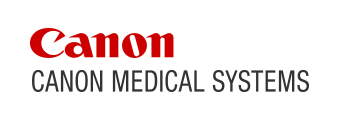PET-CT/Clinical Case Study
Prostate-Specific Membrane Antigen
PET imaging with Cartesion Prime
Director of PET-CT
Chesapeake Medical Imaging, MD
Introduction
This case study presents images from a PET-CT scan with the recently FDA-approved Flotufolastat F-18 (POSLUMA®) PSMA PET imaging tracer. The images were acquired by Cartesion Prime PET-CT, an air-cooled Premium Digital TOF PET scanner manufactured by Canon Medical Systems.
Patient History
Imaging
| Region Covered | BMI | Injected Dose | Acquisition Time | Number of Beds | Uptake Time | PSA level | Reconstruction |
|---|---|---|---|---|---|---|---|
| Skull-Base to Mid-Thigh | 25.8 kg/m2 | 8.4 mCi 18F-Flotufolastat | 3 min/bed x 3 + 2 min/bed x 3 | 6 | 71 min | 2.2 ng/ml | TOF Listmode, OSEM |
| Scan Mode | Collimation | kVp | mAs | HP | Rotation Time | Scan Range | Reconstruction |
|---|---|---|---|---|---|---|---|
| Helical | 0.5 mm x 80 | 120 | 196 | 65 | 0.5 s | 1074 mm | AiCE for CT* |
Findings
 Figure 1: Uptake in bladder (red arrow) and mediastinum (green arrow).
Figure 1: Uptake in bladder (red arrow) and mediastinum (green arrow).
Potential Acquisition Optimizations
 Figure 2: Coronals: Default protocol on the left (3 beds at 3 min/bed and 3 beds at 2 min/bed), and “time-cut” protocol on the right (6 beds at 1.5 min/bed). Axials: Default protocol on top and “time-cut” on bottom.
Figure 2: Coronals: Default protocol on the left (3 beds at 3 min/bed and 3 beds at 2 min/bed), and “time-cut” protocol on the right (6 beds at 1.5 min/bed). Axials: Default protocol on top and “time-cut” on bottom.
Conclusions
The clinical results, performance and views described in this paper are the experience of the presenter. Actual results and performance of Canon Medical’s product may be materially different due to clinical setting, patient presentation, BMI, and other factors.
References
1. https://www.cancer.org/cancer/prostate-cancer/about/key-statistics
2. Ceci, F., Oprea-Lager, D.E., Emmett, L. et al. E-PSMA: the EANM standardized reporting guidelines v1.0 for PSMA-PET. Eur J Nucl Med Mol Imaging 48, 1626–1638 (2021). https://doi.org/10.1007/s00259-021-05245-y
3. https://www.medscape.com/viewarticle/959838
* Option


